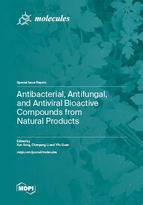Antibacterial, Antifungal, and Antiviral Bioactive Compounds from Natural Products
A special issue of Molecules (ISSN 1420-3049). This special issue belongs to the section "Natural Products Chemistry".
Deadline for manuscript submissions: closed (1 September 2023) | Viewed by 17303
Special Issue Editors
Interests: natural products; antifungal; antibacterial; anticancer; antivirus phytochemistry
Special Issues, Collections and Topics in MDPI journals
Interests: natural products; antimicrobial; anticancer; phytochemistry; antivirus
Special Issue Information
Dear Colleagues,
Due to the increasing prevalence of life-threatening bacterial, fungal and viral infections and the ability of these human pathogens to develop resistance to current drugs, there is a great need to find new compounds to combat them. Natural products are an excellent source for novel antimicrobial drug development. The aim of this Special Issue on “Antibacterial and Antiviral Bioactive Compounds from Natural Products” is to report the latest and most promising natural compounds used to combat bacteria, fungi, and viruses, and the underlying modes of action are also included. It is hoped that this Special Issue will serve as a timely reference for researchers who are interested in the discovery of potentially useful natural products for the development of novel antimicrobial drugs.
Dr. Xun Song
Dr. Chenyang Li
Prof. Dr. Yifu Guan
Guest Editors
Manuscript Submission Information
Manuscripts should be submitted online at www.mdpi.com by registering and logging in to this website. Once you are registered, click here to go to the submission form. Manuscripts can be submitted until the deadline. All submissions that pass pre-check are peer-reviewed. Accepted papers will be published continuously in the journal (as soon as accepted) and will be listed together on the special issue website. Research articles, review articles as well as short communications are invited. For planned papers, a title and short abstract (about 100 words) can be sent to the Editorial Office for announcement on this website.
Submitted manuscripts should not have been published previously, nor be under consideration for publication elsewhere (except conference proceedings papers). All manuscripts are thoroughly refereed through a single-blind peer-review process. A guide for authors and other relevant information for submission of manuscripts is available on the Instructions for Authors page. Molecules is an international peer-reviewed open access semimonthly journal published by MDPI.
Please visit the Instructions for Authors page before submitting a manuscript. The Article Processing Charge (APC) for publication in this open access journal is 2700 CHF (Swiss Francs). Submitted papers should be well formatted and use good English. Authors may use MDPI's English editing service prior to publication or during author revisions.
Keywords
- antimicrobial
- antiviral
- natural products
- drug development







